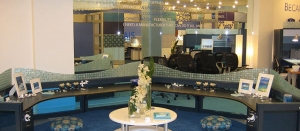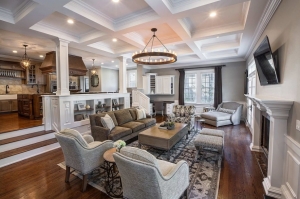Renting a villa or apartment is a low-commitment option for expatriates in the United Arab Emirates. You can find excellent properties for rent in Dubai, Abu Dhabi, Sharjah and other UAE cities.
Renting can be restrictive, however. What if you wish to customize and personalize your space?
Yes, you want a different wall color, but you can't paint the walls to suit your particular taste.
The good news is that tenants have options, and they're often more straightforward than you might suspect. Below, you'll find a handful of practical, highly specific methods you can use to refinish and redecorate without incurring your landlord's ire and violating the terms of your contract.
1. The Fine Print
Before you whip out that hammer—metaphorically speaking—get your lease contract out and read the fine print. Confirm the landlord's stance on painting walls, installing shelves, retiling the bathroom, and whatever it is you wish to do with the rental. (Actually, the time to do this is before you sign the lease, but it is what it is.)
If the terms are murky, ask questions. It's best to do this in writing (think email) so you have a clear record of your landlord's responses if any future misunderstandings arise. Landlords often say no to permanent alterations but might be open to simpler renovations if you promise to reverse them before you leave.
Why do this? Breaking the terms of your contract could mean losing your security deposit or getting evicted.
2. Peel-and-Stick Wallpaper for Instant Flair
Do you feel like the bland walls are ruining everything? Peel-and-stick wallpaper can be the hero that saves your day. Available in various designs, from subtle lines to loud geometric bursts, these temporary marvels adhere like a champion but peel off (feels like it, anyway) just as cleanly as the protective film on a brand-new phone.
Here's how to do it right:
- Measure the walls precisely so you don't get random leftover bits.
- Wipe the walls with a damp cloth, let them dry, and apply the wallpaper carefully, starting from the top left or right corner and working your way to the other side and down.
- Use a paperhanging tool to remove air bubbles and flatten the paper. You can use a credit card, too.
- Try peeling off a section after attaching it securely to ensure the wallpaper is as easy to remove as it is to hang.
Note: Peel-and-stick wallpaper works best on painted, smooth walls. Textured surfaces might present challenges with adhesion (and removal), but high-quality papers should work fine.
3. Temporary Flooring Solutions
If your rental's flooring looks dated or your landlord insists on keeping that tripping hazard of a 1970s psychedelic pattern, installing new flooring is a great idea but probably not something you're permitted to do. It's okay. There's temporary flooring you can use instead.
Your options include self-adhesive vinyl tiles and interlocking laminate planks, which are easy to install and can transform your space in a matter of hours.
Here's how you "renovate" your floors:
- Clean and dry: Vacuum, mop and dry the floor to clear out dust.
- Measure twice, cut once: You'll do less guesswork and waste fewer materials if you measure precisely. Keep a utility knife handy for trimming pieces.
- Line up edges: If you're using vinyl tiles, ensure you follow the alignment cues. Overlapping might cause warping.
- Press down firmly: A rolling pin or floor roller helps secure vinyl tiles to the floor.
Important: Make sure the tile adhesive (if using self-adhering vinyl tiles) doesn't react poorly with the existing surface. Read the installation instructions carefully and do a small test in a less visible corner just to make sure.
4. No-Hammer Wall Art
Most landlords have a no-nail and no-screw-in-wall policy—but that wall art still needs hanging. What should you do? Use removable adhesive hooks and strips. They're available in nearly every hardware store.
Here are tips on how to do this:
- Use hooks with the right capacity. How heavy is your wall art? Find a hook that can carry more than that.
- Clean and dry the surface properly. Follow the instructions that came with the product to make sure what you hang stays up.
- Peel off carefully when it's time to remove (and move). A slow, angled motion usually works best.
5. Kitchen Cabinet Makeovers
Kitchen cabinets may be total eyesores, but a full-blown remodel is rarely in the cards for a tenant. Consider vinyl wraps or removable kitchen cabinet contact paper. They come in a variety of modern designs, metallic finishes and warm wood-grain patterns. You have many options to choose from, so pick whichever suits your style.
Here's how to proceed with your operation kitchen cabinet:
- Thoroughly clean the cabinet doors. Grease or grime will ruin adhesion.
- Carefully measure the cabinet faces and precisely cut the contact paper.
- Apply slowly, smoothing as you go to prevent wrinkles and air bubbles.
- Trim excess contact paper around the edges with a craft knife.
Contact paper is just self-adhesive vinyl designed for cabinet wrapping. It's easy to apply and straightforward to remove, and it shouldn't harm the cabinets' original finish.
Removable Renovations
Want to rent but unsure if you can personalize your space? Go ahead with the lease on that Bloom Properties apartment or villa. It's probably well-designed already, so you'll have fewer things to modify. Check your contract for the fine print on renovations, and for the bit your contract says you can't change, use peel-and-stick wallpaper, interlocking laminate floors, adhesive strip hooks, and cabinet wraps. Sometimes, the smallest of changes can make the most tremendous difference.






